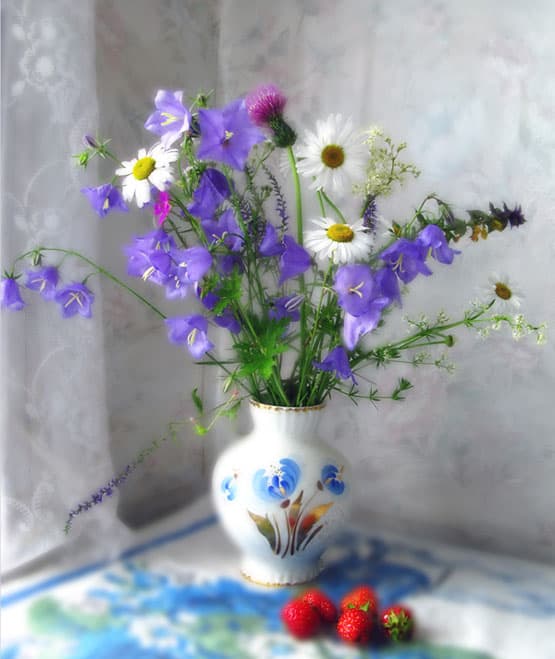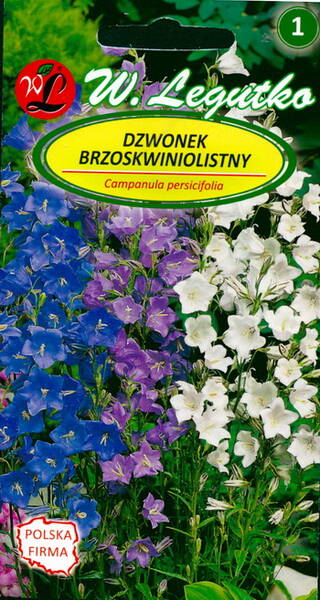A delightfully beautiful herald of summer!
A hardy perennial plant. A slender, strong stem 60-100 cm high rises from a rosette of basal leaves in the middle of summer. The leaves are glossy, with a serrated edge. The flowers are large, broadly bell-shaped, double, 5-6 cm in diameter, collected in a loose, racemose inflorescence. Blue bells shine in meadows and glades: purple, blue, light blue, white.
Blooms from June and almost all summer. To preserve the beauty of the flower garden, faded inflorescences are cut off.
Bells are good everywhere: in flowerbeds, in discounts, on rocky hills, they provide elegant material for cutting.
Agrotechnics.
Prefers fertile, loose, well-drained soils, thrives well in both open and shaded areas. Mainly propagated by seeds. Seeds can be sown in autumn or spring in the ground or in greenhouse boxes. Seedlings quickly bush, so they are planted in the soil at a distance of 30-35 cm from each other; they bloom in their second year. Further care consists in weeding, loosening and watering. Watering is required only during prolonged heat. After flowering, the plants are pruned.

An evergreen perennial growing to 1m by 0.45 m. It is hardy to zone 3 and is not frost tender. It is in leaf all year, in flower from June to August, and the seeds ripen from August to October.
The flowers are hermaphrodite (have both male and female organs) and are pollinated by Bees, flies, beetles and Lepidoptera (Moths & Butterflies). The plant is self-fertile. We rate it 4 out of 5 for usefulness. The plant prefers light (sandy) and medium (loamy) soils and requires well-drained soil. The plant prefers neutral and basic (alkaline) soils. It can grow in semi-shade (light woodland) or no shade. It requires moist soil.
Habitats and Possible Locations: Woodland, Sunny Edge, Dappled Shade. Cultivation details Easily grown in ordinary garden soil. Prefers a moist but well-drained rich sandy loam and a neutral or alkaline soil in sun or partial shade. Succeeds in light woodland. Plants are hardy to at least -15°C.
The species in this genus do not often hybridize and so seed can generally be relied upon to come true. The plants are self-fertile. A very ornamental plant, there are many named varieties. It was at one time grown as a culinary vegetable, but is now only grown as an ornamental plant.
The sub-species Campanula persicifolia crystalocalyx has larger leaves than the species and so is more suitable as a food crop. A very long-lived and easily grown plant, it is best divided every other year. Slugs are very fond of this plant and can cause severe damage even to large plants. Members of this genus are rarely if ever troubled by browsing deer.
This plant is a potential winter salad plant, it retains a basal rosette of leaves all winter.
Propagation Seed - surface sow spring in a cold frame. The seed usually germinates in 2-4 weeks at +18°C. When they are large enough to handle, prick the seedlings out into individual pots and grow them on in a cold frame for at least their first winter.
Plant them out into their permanent positions in late spring or early summer, after the last expected frosts. Basal cuttings in spring. Harvest the shoots when they are about 10-15 cm long with plenty of underground stem. Pot them up into individual pots and keep them in light shade in a cold frame or greenhouse until they are rooting well.
Plant them out in the summer.
Division in spring or autumn. Very easy, larger clumps can be replanted direct into their permanent positions, though it is best to pot up smaller clumps and grow them on in a cold frame until they are rooting well.
Plant them out in the summer or following spring.
Eng.: Peach-Leaf Bellflower, Peach-Leaved Bellflower. Bot. syn.: Campanula amabilis Leichtl.












